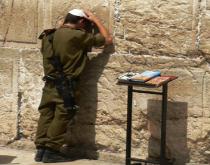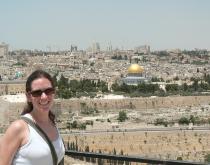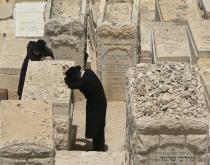


Jerusalem:
The Holy
Land...
The Holy
Land...
An Israeli soldier praying at the Western Wall.
On the Mount of Olives.
Haredi people at the cemetery.
June 7, 2006
Jerusalem. The Holy Land. For the Jews. For the Christians. For the Muslims.
The entire Old City lies in one square kilometer of narrow, winding alleyways where it’s impossible to not get lost. This ‘Old
City’ encompasses three-thousand years of religious history.
It’s quite a rare sight to see three of the main religions of the world in such a small space. In addition to the quarters for the
Jews, Muslims and Christians, there is also an Armenian Quarter. Armenians were the first to officially embrace
Christianity. They have been in Jerusalem ever since the 4th century when this was named as their spiritual capital. Only
about 1500 still exist after an attempted genocide in 1915 which killed almost 1.5 million Armenians. In some ways it’s nice
to see people of different beliefs living so closely to one another somewhat in peace. At the same time, the different
occupants stick to the confines of their ‘sections’ and it’s obvious that underlying tensions exist.
I’m now going to take a moment to address the three main religious sites in the Old City:
Temple Mount: Al-Aqsa Mosque and the Dome of the Rock – The Temple Mount is an extremely holy place for both
Jews and Muslims. For Jewish people, this is where King Solomon built the First Temple and upon its ruins, the Second
Temple was built. After Muslim conquest, the two structures that now exist were erected: Al-Aqsa Mosque and the Dome
of the Rock. The latter houses the Foundation Stone – tradition states that this is from which the world was established.
The Dome of the Rock was also where the Prophet Mohammed launched himself into heaven.
Western Wall – This is deemed as the most holy of Jewish sites. Here you can witness Jewish people mourning the loss
of the Second Temple (which was destroyed by the Romans in 70 AD). The Western Wall is the only remnant of that
temple. The houses that used to lie right near the wall were all destroyed in the Six Day War in 1967 and now the plaza sits
there today. There are two sections: one for men and a smaller one for women. I was fortunate enough to be there on a
Monday when bar mitzvahs take place (in addition to Thursdays and Saturdays) and witnessed the excitement in the air as
rabbis and the boys walked around with the Torah. The women of the family looked on from their side of the wall as the
males approached and this was their opportunity to snap photos and throw candy. This was definitely a change from the
somber mood that I witnessed every other time I was there.
Church of the Holy Sepulchre – This is the place where Jesus Christ was crucified, buried and resurrected. This is an
extremely emotional place for Christians. I can’t count how many people I saw crying there. Jesus’ burial site is a moving
sight for most who come into the church- I saw one woman lay out at least twelve photographs, a few objects and her
passport and then rested herself upon the marble and prayed.
If you didn’t know too much about Jerusalem’s past, hopefully that helps with understanding just why it is a city that is so
important to so many. There is actually something labeled as ‘Jerusalem Syndrome’. This is when people with a
few…um…mental problems come to Jerusalem and just lose it. People come believing they are some religious figure (i.e.
Jesus, the Virgin Mary, Samson, Moses, King David, etc.) and then they completely lose it from there. They say it happens
to about 200 visitors a year (the demographic seems to be 20-30 year old Christians and Jews from North America and
Western Europe who had religious upbringings). Sadly, I can’t report witnessing any such behavior.
The Old City offers more than just the three main religious sights: it is also bustling with bazaars all over the place. The
section that you are in will play a role in the items being sold and what language you see written. Menorahs, yarmulkes and
Star of David items can be found in the Jewish Quarter. Different things showing Jesus Christ can be found in the Christian
Quarter. And hookahs and tobacco (amongst many other things) can be found in the Muslim Quarter.
The Ramparts Walk was a great way to get perspective of the Old City from the top. This offered great views of both the
Old City and the New City as we walked along the top of the city walls.
Walking up to the Mount of Olives gave an extremely rewarding panoramic view of the Old City. We could have taken a
bus but then there’s not the same sense of achievement when seeing the sweeping views. The main standout feature of
seeing the Old City from the hills is the gold dome of the Dome of the Rock on the Temple Mount. The landscape around
the Old City is also fantastic with olive trees on the bottom and then as you ascend to the top, you reached the world’s
largest and oldest Jewish cemetery. We saw many of the 'Haredim' praying there (see below to find out what that term
means).
Outside of seeing the religious sites, Jerusalem was also an extraordinary people watching experience. I thank the Haredim
for this. While I don’t want to make judgments, I’m going to. These people are a bit nutso. These are the ultra-Orthodox
Jews that reject modern secular culture. They dress in all black with long curls near their ears and big black hats. Their
male children also come adorned with these long curls. They don't work. They seem to just pray, pray and then pray some
more (and bounce around while doing so). I’m not proud to admit this but I became the ‘Jenarazzi’ as I just couldn’t help
but take picture after picture of these people. They also want to suck people into their ultra-Orthodox world. They stand at
bus stations and along the street to lure people. These are the fanatics of Judaism and they are in full-force in Jerusalem.
From what I understand, they are totally against the peace process with Palestine and have visions of building a ‘Third
Temple’ where the Dome of the Rock (one of the most religious sites in the world for Muslims) lies. I feel like telling them
‘fat chance’ and that it’s not going to happen. It also seemed apparent that these people like to reproduce. Maybe I’m
generalizing, but I saw many with lots of kids. These kids were already being primed to follow in their fathers’ footsteps
even at an age where they were confined to their strollers – the boys already had long twists forming near their ears that
their parents clearly took time to twirl into a curl. Their future will consist of a lot of praying and bouncing.
Depending on what street I turned onto next in the Old City, the food, music, style of dress and language changed almost
instantaneously. A visit to Jerusalem was like getting a different taste of religion and culture at every corner.
Jerusalem. The Holy Land. For the Jews. For the Christians. For the Muslims.
The entire Old City lies in one square kilometer of narrow, winding alleyways where it’s impossible to not get lost. This ‘Old
City’ encompasses three-thousand years of religious history.
It’s quite a rare sight to see three of the main religions of the world in such a small space. In addition to the quarters for the
Jews, Muslims and Christians, there is also an Armenian Quarter. Armenians were the first to officially embrace
Christianity. They have been in Jerusalem ever since the 4th century when this was named as their spiritual capital. Only
about 1500 still exist after an attempted genocide in 1915 which killed almost 1.5 million Armenians. In some ways it’s nice
to see people of different beliefs living so closely to one another somewhat in peace. At the same time, the different
occupants stick to the confines of their ‘sections’ and it’s obvious that underlying tensions exist.
I’m now going to take a moment to address the three main religious sites in the Old City:
Temple Mount: Al-Aqsa Mosque and the Dome of the Rock – The Temple Mount is an extremely holy place for both
Jews and Muslims. For Jewish people, this is where King Solomon built the First Temple and upon its ruins, the Second
Temple was built. After Muslim conquest, the two structures that now exist were erected: Al-Aqsa Mosque and the Dome
of the Rock. The latter houses the Foundation Stone – tradition states that this is from which the world was established.
The Dome of the Rock was also where the Prophet Mohammed launched himself into heaven.
Western Wall – This is deemed as the most holy of Jewish sites. Here you can witness Jewish people mourning the loss
of the Second Temple (which was destroyed by the Romans in 70 AD). The Western Wall is the only remnant of that
temple. The houses that used to lie right near the wall were all destroyed in the Six Day War in 1967 and now the plaza sits
there today. There are two sections: one for men and a smaller one for women. I was fortunate enough to be there on a
Monday when bar mitzvahs take place (in addition to Thursdays and Saturdays) and witnessed the excitement in the air as
rabbis and the boys walked around with the Torah. The women of the family looked on from their side of the wall as the
males approached and this was their opportunity to snap photos and throw candy. This was definitely a change from the
somber mood that I witnessed every other time I was there.
Church of the Holy Sepulchre – This is the place where Jesus Christ was crucified, buried and resurrected. This is an
extremely emotional place for Christians. I can’t count how many people I saw crying there. Jesus’ burial site is a moving
sight for most who come into the church- I saw one woman lay out at least twelve photographs, a few objects and her
passport and then rested herself upon the marble and prayed.
If you didn’t know too much about Jerusalem’s past, hopefully that helps with understanding just why it is a city that is so
important to so many. There is actually something labeled as ‘Jerusalem Syndrome’. This is when people with a
few…um…mental problems come to Jerusalem and just lose it. People come believing they are some religious figure (i.e.
Jesus, the Virgin Mary, Samson, Moses, King David, etc.) and then they completely lose it from there. They say it happens
to about 200 visitors a year (the demographic seems to be 20-30 year old Christians and Jews from North America and
Western Europe who had religious upbringings). Sadly, I can’t report witnessing any such behavior.
The Old City offers more than just the three main religious sights: it is also bustling with bazaars all over the place. The
section that you are in will play a role in the items being sold and what language you see written. Menorahs, yarmulkes and
Star of David items can be found in the Jewish Quarter. Different things showing Jesus Christ can be found in the Christian
Quarter. And hookahs and tobacco (amongst many other things) can be found in the Muslim Quarter.
The Ramparts Walk was a great way to get perspective of the Old City from the top. This offered great views of both the
Old City and the New City as we walked along the top of the city walls.
Walking up to the Mount of Olives gave an extremely rewarding panoramic view of the Old City. We could have taken a
bus but then there’s not the same sense of achievement when seeing the sweeping views. The main standout feature of
seeing the Old City from the hills is the gold dome of the Dome of the Rock on the Temple Mount. The landscape around
the Old City is also fantastic with olive trees on the bottom and then as you ascend to the top, you reached the world’s
largest and oldest Jewish cemetery. We saw many of the 'Haredim' praying there (see below to find out what that term
means).
Outside of seeing the religious sites, Jerusalem was also an extraordinary people watching experience. I thank the Haredim
for this. While I don’t want to make judgments, I’m going to. These people are a bit nutso. These are the ultra-Orthodox
Jews that reject modern secular culture. They dress in all black with long curls near their ears and big black hats. Their
male children also come adorned with these long curls. They don't work. They seem to just pray, pray and then pray some
more (and bounce around while doing so). I’m not proud to admit this but I became the ‘Jenarazzi’ as I just couldn’t help
but take picture after picture of these people. They also want to suck people into their ultra-Orthodox world. They stand at
bus stations and along the street to lure people. These are the fanatics of Judaism and they are in full-force in Jerusalem.
From what I understand, they are totally against the peace process with Palestine and have visions of building a ‘Third
Temple’ where the Dome of the Rock (one of the most religious sites in the world for Muslims) lies. I feel like telling them
‘fat chance’ and that it’s not going to happen. It also seemed apparent that these people like to reproduce. Maybe I’m
generalizing, but I saw many with lots of kids. These kids were already being primed to follow in their fathers’ footsteps
even at an age where they were confined to their strollers – the boys already had long twists forming near their ears that
their parents clearly took time to twirl into a curl. Their future will consist of a lot of praying and bouncing.
Depending on what street I turned onto next in the Old City, the food, music, style of dress and language changed almost
instantaneously. A visit to Jerusalem was like getting a different taste of religion and culture at every corner.
Back to Israel